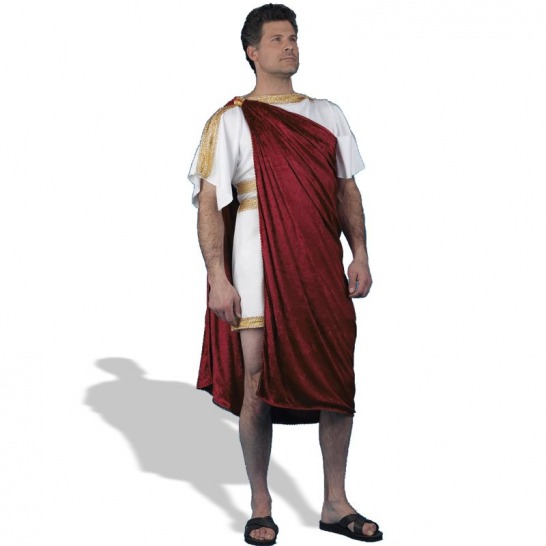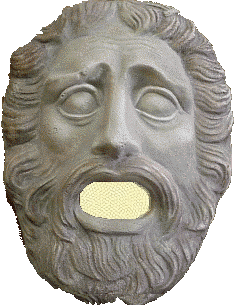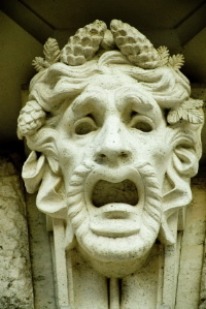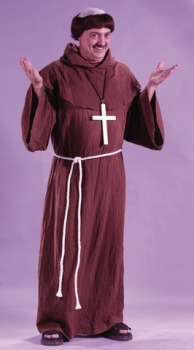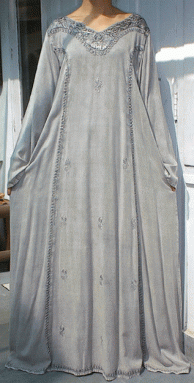Costume Design
Aren't you excited to design and make your own costumes from each of these time periods! I know I am! Just watching theater makes me want to be a part of it, and this is a great way to do just that! Why don't we get started! Grab your scissors, paint, and needle and thread and let's get to work!
Greek Costumes
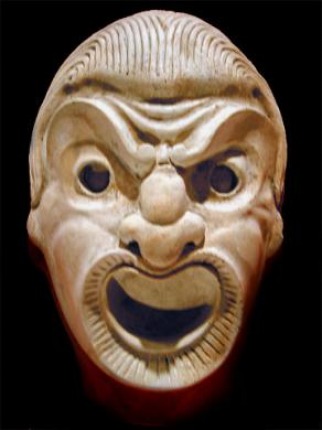
The major element in Greek costuming was the mask. It covered the entire head and included hair, beards, and other facial features. We will be making our own masks to describe our tragic character. Masks were important because then actors could play multiple roles and the audience would recognize the different characters. I want each of you to create two masks so you can show two completely different characters. I want you to base one of the masks on someone you most want to be like. I want the other to show your tragic flaw.
Other than the masks, Greek costumes were pretty conventional. Grecian actors wore Tunics, and their costumes were based on everyday life. While tunic's aren't very conventional for our day and age, they should be fairly easy to make.
It is interesting to note that at the beginning of the Grecian theater period, costumes were elaborate, but as time passed, the costuming became more standardized.
Other than the masks, Greek costumes were pretty conventional. Grecian actors wore Tunics, and their costumes were based on everyday life. While tunic's aren't very conventional for our day and age, they should be fairly easy to make.
It is interesting to note that at the beginning of the Grecian theater period, costumes were elaborate, but as time passed, the costuming became more standardized.
Roman Costumes
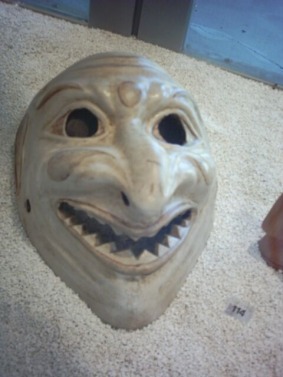
Masks were also worn in Roman theater. They were linen and covered the head completely. There was a change, however. Masks began to be made with one side being happy and one side being sad to indicate a change of emotion without the actor having to change his mas. The costuming was very similar to Greek. It is unclear exactly what the Roman masks looked like, because for a long time it wasn't clear whether masks were used in Roman theater or not.
Like the Greeks, they also wore tunics. However, each of the stock characters had their own costume that didn't change throughout the shows.
The pantomime wore a mask with a closed mask that were also less exaggerated. Some mime characters, probably the fools, had shaved heads. Others, the right, wore lavish clothing.
For your Roman mask, I want you to take this smiling mask I give you and paint it in a way that describes your feelings. True, these masks weren't painted, I feel that creativity will help you understand theater a little better.
Like the Greeks, they also wore tunics. However, each of the stock characters had their own costume that didn't change throughout the shows.
The pantomime wore a mask with a closed mask that were also less exaggerated. Some mime characters, probably the fools, had shaved heads. Others, the right, wore lavish clothing.
For your Roman mask, I want you to take this smiling mask I give you and paint it in a way that describes your feelings. True, these masks weren't painted, I feel that creativity will help you understand theater a little better.
Medieval Costumes
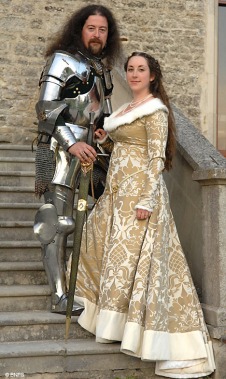
For the most part, actors from this time period wore clothing from medieval time. Even historical characters were dressed in the medieval equivalent. Roman soldiers were attired in medieval armor. Jewish high priest wore robes of Catholic prelates. God was cast as an emperor or a pope. Devils were made to look like great birds of prey, monsters, or creatures with scales or horns. Actors had to provide their own costumes. This meant that actors often incurred huge expenses in supplying their own costume; especially those who were supposed to be playing a rich character. The director would give each actor a detailed description of what their costume was supposed to look like.
Because this is such a broad area, I want you to create a costume for one of the plays you have written. I want you to imagine your play is set in medieval times and create a costume for one of your characters. Be creative, and don't hesitate to ask for ideas. Sometimes costume design in a collaborative effort.
Because this is such a broad area, I want you to create a costume for one of the plays you have written. I want you to imagine your play is set in medieval times and create a costume for one of your characters. Be creative, and don't hesitate to ask for ideas. Sometimes costume design in a collaborative effort.
Renaissance Costumes
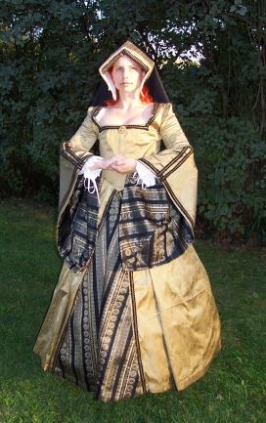
Costumes followed the traditions of medieval English theater. The costumes were not necessarily accurate for the time they were portraying. The costumes they wore were mostly contemporary. The majority of what was worn was things that were worn in real life. It is interesting how far theater has come. now we wear costumes to represent the time period, not just the character.
Costuming was probably the most important visual element of this time period. Because costumes were seen at close range, they used high quality materials to supply their costumes. The troupes carried large quantities of costumes with them, and a tireman (wardrobe keeper) kept track of them. Sometimes noblemen would give these acting companies their old clothes and sometimes the royal family would give grants to these companies that helped with wardrobe.
It is believed that traditional costumes, such as Greek and Roman were important. Actors would wear a toga over their clothes to signify this.
For out last costume assignment, I want you to create what you think Prince Hamlet should wear. There are multiple interpretations throughout all of the plays of Hamlet, but I want you to see your unique interpretation.
Costuming was probably the most important visual element of this time period. Because costumes were seen at close range, they used high quality materials to supply their costumes. The troupes carried large quantities of costumes with them, and a tireman (wardrobe keeper) kept track of them. Sometimes noblemen would give these acting companies their old clothes and sometimes the royal family would give grants to these companies that helped with wardrobe.
It is believed that traditional costumes, such as Greek and Roman were important. Actors would wear a toga over their clothes to signify this.
For out last costume assignment, I want you to create what you think Prince Hamlet should wear. There are multiple interpretations throughout all of the plays of Hamlet, but I want you to see your unique interpretation.
